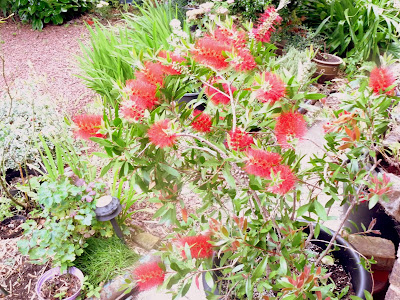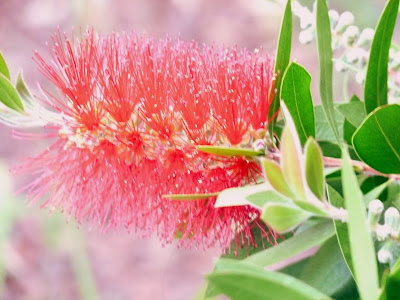
|
|
Bottlebrush In The Garden By Raintree Annie |
Four years ago we bought our first Bottlebrush. It is a plant I had wanted for years so was very happy to bring one home. The first picture shows it growing in a large pot in our garden.
However, when we first brought it home, at that time, I knew very little about how to care for it.
Most of my plants were firmly outdoor garden plants but the bottle brush in our climate always seems to me to be halfway between a houseplant and a garden plant.
Learning About Bottlebrush
So I knew I needed to learn about how to grow and care for it. Ours is
the Callistemon citrinus or Crimson Bottlebrush. It is
fairly common and easy to find. It is quite hardy, but I find requires
winter shelter. It produces its stunning flowers mainly in high in
summer with another smaller flush in Autumn and has been forgiving about
my pruning to shape it.
There are several more cultivars including Alpine and Weeping varieties
which are lovely. There are even Lemon Bottlebrush with lemon coloured
flowers. So there are many to choose from for your needs.
The smaller dwarf varieties are especially useful for a small garden,
patio or even a balcony. If you do not have a garden as such, a dwarf
Bottlebrush would be lovely to bring some colour and style to a small
outdoor space or indoor conservatory.
The name Bottlebrush comes from the beautiful red flower spikes
that grow right at the end of the branches and simply look like a bottle
brush!
We knew it needed to grow in a very mid climate as the plant originates
in Australia. We have a temperate climate sometimes it is very
warm but most of the time it is mild or cool and in winter can be
very cold indeed sometimes freezing conditions with frost and snow.
So we decided it would be best to grow it in a large pot so that we
could move it into a sheltered area easily.
Bottlebrush also requires free draining soil preferably on the acidic
side and our soil is heavy clay. We did not think it would like the clay
soil as it gets very cold and sodden in winter and sometimes becomes
frozen and rock like. However, it is thriving in the free-draining
ericaceous compost with grit and sand I added to the pot.
I positioned it in full sun so it could take advantage of as much warmth
and sunshine as possible. Ideally, it needs to be placed in
a south-facing position or failing that a west facing position.
I have to admit for the first two years I was a little disappointed as
there were no flowers. It was bought as a small plant though so I knew
that as a gardener we do need a little patience. I also learned a lot the
first year about how to care for it and it was very forgiving. With a
little care and attention and doing the right things the plant was very
happy and I reaped the rewards.
The first year it flowered I was ecstatic!! The flowers were so
beautiful and so prolific!!

|
|
Bottlebrush Spike By Raintree Annie |
Pruning And Care Of Bottlebrush
Especially in a pot it is necessary to water Bottlebrush regularly
and to feed at least once a year in Spring and after flowering. I give
an ericaceous feed and water when I feel the soil is dry. In the
ground you may only need to water if it is very dry for prolonged
periods of time.
I have rarely pruned our bottlebrush, only really to shape it. I prefer
to just prune back lightly and cut just behind the faded flower
spikes each year. Cutting back into the old wood is not advisable.
I have grown it like a shrub, but if you like you can prune it to make
it look more tree-like with a single longer trunk. The variety I
have can grow up to 15 feet tall so depending on where you are growing it,
you may need to do light pruning to keep it in check annually or every
other year. However, it can take 10 to 20 years to grow to its full height
so it is not a plant that will get out of control very quickly.
Of course with the dwarf varieties, the plant outgrowing its
available space will not be an issue and pruning is simply to remove dead
or damaged branches and clip to shape. If I got another one -which is very
likely- I will buy a dwarf variety.
I love the leaves, they are evergreen, aromatic, lance-shaped and
the older ones are quite thick and dark green while the young ones are
light green often just tinged with red and very soft and really lovely
to touch.
The flowers here tend to bloom in high to late summer though this year
ours still flowered in late November. In the winter I now keep it in our
porch area which is very sheltered. In late autumn I cover it in several
layers of thick garden fleece and so far it has been just fine throughout
winter. If I had a conservatory or orangery I would certainly keep it in
there all year round.
I have never known ours suffer from any pests or diseases.
However, it can be susceptible to red spider mite, scale insects and
mealybugs though these tend to be more prevalent when grown in a
greenhouse situation.
In terms of usefulness to wildlife, our bees love it in summer and can
often be found happily feeding upon it!
Bottlebrush is a beautiful evergreen plant requiring minimal care and
attention once you understand its needs. It looks great all year round
and especially gorgeous in summer and autumn with its vibrant
flower spikes. It is a beautiful plant to grow and lovely to give
as a gift for anyone who appreciates plants.
As long as you have one of a garden, conservatory, greenhouse,
orangery, a sheltered sunny spot, suitable soil conditions, or a large
pot and a means of keeping it safe and sheltered in colder conditions I
would recommend growing it.




This was my first look at a bottlebrush tree, and yours is wonderful! I love the bright red, spiky blooms (that really do look just like a bottle brush), set against the backdrop of those bright green, slender, tapered leaves. I wish I had a spot (and climate) where I could grow one successfully. It's so cheerful and exuberant!
ReplyDeleteI love Bottlebrush plants. It took a few years to flower and I had to learn more about its care. Yes I agree they are so cheerful and really brighten up an area. If I lived in a colder climate I would be growing it in a conservatory or greenhouse for sure but it manages well here as long as I keep it sheltered and fleece wrapped in winter and in a warm sunny spot in summer it is now doing well! Thank you for visiting!
DeleteWhat a beautiful flower! I don't believe I have ever seen one before. We have such hard winters, it would most likely need to be a houseplant for me, although I might be able to set it out in a pot during the spring & fall like you do. I doubt it would do well in the ground here, which is probably why I have never seen one. I love it and you certainly made me want one. Yikes, I'm not good with houseplants, but it sure is a temptation!
ReplyDeleteYes the flowers are gorgeous! If you live in an area with hard winters it would probably be best to keep in a large pot and bring it in to a conservatory or greenhouse if you have one. A dwarf variety would be easier to handle if you need to move it a lot.I have found the bottlebrush to be very forgiving once you get the basics right.
DeleteWhat a beautiful plant. I've neither seen or heard of this plant before - but that means little, since my gardening skills are quite limited. It's very different. As a houseplant or a gift for someone it would be lovely. I'll have to ask about this one the next time I send my mom a flower arrangement - the "Bottlebrush Plant" - it's hard to forget that name :)
ReplyDeleteBottlebrush is a lovely plant and I agree would make a beautiful gift, perhaps with some care instructions if the person has not grown a bottle brush before. I had not thought about it as part of a flower arrangement but that would be interesting to see!Yes I agree its a great name!
Deletere my above comment - I meant to say "it's not hard to forget the name" - lol :)
ReplyDeleteNo worries I knew what you meant Barbara !! :)
DeleteRaintree Annie- you make gardening sound so interesting. I have never been a flower gardener, but my grandmother definitely was. I wish she were still around so I could ask her if she ever grew this bottlebrush plant. It is truly a lovely plant. Thanks so much for describing it so well.
ReplyDeleteThank you so much, I guess I just love plants and find them so interesting and fascinating to learn about. I know what you mean, I wish I could ask my grandparents some gardening questions. I do not think you ever stop learning as a gardener.
DeleteThis is one plant that has eluded me. I have killed more than my share of this lovely plant and I know it can be difficult to care for. I guess I just don't have what it wants. I am in envy of your ability to keep this lovely interesting plant growing and thriving. I will have to admire yours on a regular basis. Thanks Jasmine for a great article on it's care, maybe I will have to try again!
ReplyDeleteYou are a wonderful and talented gardener Olivia and I have learned a lot from you. Bottle brush can be a bit of a challenge depending on your environment. I had to learn all over again for this plant in my climate. It was well worth it when those first flowers bloomed I was beyond excited lol !! Wish I could share a cutting with you ! If you have a go try it in a large pot with ericaceous soil in a very sunny position and lots of shelter in winter and see how it goes! :)
DeleteA lot of this grows in my neighborhood and it always seems to be blooming. It is beautiful in bloom, but I didn't learn to appreciate it until I moved here. We had one in the backyard of our first house. I didn't appreciate it much there because it grew right next to the clothesline. The two were incompatible. Bottlebrush is not meant to bloom next to where you hang clothes. Just saying.
ReplyDeleteHow wonderful to be able to see the beautiful bottlebrush growing in your neighbourhood!Must look stunning when they are all in bloom! Is the issue with hanging clothes near a bottle brush the pollen? My bottlebrush is in a pot so no where near I hang clothes but certainly something to bear in mind if you are planting it out in a garden.
Delete